Hitler
 The making of the weapons of warfare is not always an easy task, and sometimes there is a lot of trial and error. When the different countries decided to begin making tanks, there were as many different styles as countries involved. That might sound like a good thing, but making an effective battle tank is no small undertaking, even in the best of times. Building one under the pressure of war is next to impossible. In fact, given the complexity of the machines, high costs, and stress of combat, I don’t know how they managed to make them work at all. Of course, not all tank designs were failures. There were a number of successful tanks, of course. If there hadn’t been we wouldn’t have tanks today. They would have just given up. Nevertheless, there were also a lot of failures.
The making of the weapons of warfare is not always an easy task, and sometimes there is a lot of trial and error. When the different countries decided to begin making tanks, there were as many different styles as countries involved. That might sound like a good thing, but making an effective battle tank is no small undertaking, even in the best of times. Building one under the pressure of war is next to impossible. In fact, given the complexity of the machines, high costs, and stress of combat, I don’t know how they managed to make them work at all. Of course, not all tank designs were failures. There were a number of successful tanks, of course. If there hadn’t been we wouldn’t have tanks today. They would have just given up. Nevertheless, there were also a lot of failures.
Tanks like the Bob Semple Tank, so named for the New Zealand politician tasked with designing it. Sadly, this dud was built with what limited materials or expertise, Semple and his team could get their hands on. The tank was designed after a picture on an American postcard. Basically, it was a tractor wrapped in steel with six 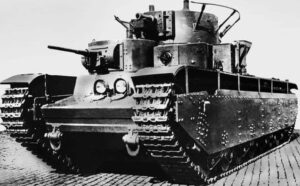 machine guns poking out at different angles. Ok, it might have looked like a tank, but that was about it. To change gear, it had to come to a complete stop…not a good way to ward off the enemy. One of the gunners of the eight-man crew had to lie on a mattress to squeeze into the cramped compartments, so he was pretty much done for it if the tank caught fire.
machine guns poking out at different angles. Ok, it might have looked like a tank, but that was about it. To change gear, it had to come to a complete stop…not a good way to ward off the enemy. One of the gunners of the eight-man crew had to lie on a mattress to squeeze into the cramped compartments, so he was pretty much done for it if the tank caught fire.
In true Hitler style, the Panzer VII Maus was the largest tank ever built. The size of the tank was its biggest downfall. The tank used too much fuel to be a logical option for a country running low on funds. In addition, the tank was so huge that it couldn’t maneuver through tree covered areas, and it was so slow that it couldn’t catch other tanks. It was also a sitting duck for aircraft looking to bomb it, because it just went so slowly.
The T-35, built in the Soviet Union, was the pride of the Red Army…until it was actually used in combat. This tank was outdated before it was built. A five-turret behemoth, it was a battleship on some seriously slow- moving treads. About the only thing it was good for was looking good in a parade. On the field…well, that was another matter. The T-35 required a 10-man crew to operate and many more to maintain. More than half of the 48 tanks used in the first attack in 1941, broke down before reaching the front.
moving treads. About the only thing it was good for was looking good in a parade. On the field…well, that was another matter. The T-35 required a 10-man crew to operate and many more to maintain. More than half of the 48 tanks used in the first attack in 1941, broke down before reaching the front.
Of course, there were other duds too. Probably too many to mention here. The tank was a good idea, and the good ones were like a rolling force field. The problem was that the ones that were poorly designed, rather outnumbered the ones that were good. I suppose that is why there are relatively few tank designs.
 The Rock of Gibraltar is a unique rock located in the British territory of Gibraltar, near the southwestern tip of Europe on the Iberian Peninsula, and near the entrance to the Mediterranean. It is a huge monolithic limestone promontory that stands high above the water, although it actually sits on the edge of the land. During World War II, the rock was actually a war tool, and an amazing one at that. The British Army dug a maze of defensive tunnels inside the rock during the war, and the massive cliff is famous for the more than 30 miles of cleared space that served as a housing area for guns, ammunition, barracks, and even hospitals for wounded soldiers.
The Rock of Gibraltar is a unique rock located in the British territory of Gibraltar, near the southwestern tip of Europe on the Iberian Peninsula, and near the entrance to the Mediterranean. It is a huge monolithic limestone promontory that stands high above the water, although it actually sits on the edge of the land. During World War II, the rock was actually a war tool, and an amazing one at that. The British Army dug a maze of defensive tunnels inside the rock during the war, and the massive cliff is famous for the more than 30 miles of cleared space that served as a housing area for guns, ammunition, barracks, and even hospitals for wounded soldiers.
Recently, it was discovered that the rock held another, previously unknown secret use. Hidden in the famous rock is a secret chamber, known as the “Stay Behind Cave.” The cave measures 45 x 16 x 8 feet, and it has long been the site of a top-secret World War II plot called Operation Tracer. British Intelligence found out in 1940, that Hitler was planning to invade Gibraltar and cut off Great Britain from the rest of the British Empire. It was another part of their evil plan to take over the world, and they needed Britain out of the way to accomplish their objective. Once the British knew about this plot, the British Admirals suggested that a secret room be constructed within the Rock of Gibraltar, where six men would hide and observe from two small openings any movement they could see on the harbor. 
Six men were selected. One of the men even agreed to Operation Tracer before he was even told what it was. That fact doesn’t shock me as much as the other men knowing about it and still being willing to participate. The plan was to seal the six men inside the secret chamber with enough supplies to last them a year (some say the food stores could have actually carried the men for 7 years) was put into action. The plan had to take in any eventuality, so it was said that if one of the men were to die, they would be buried in the brick floor. The only way the men could escape back into the outside world would be if Germany was defeated before the year’s-worth of supplies ran out. Construction on the chamber began in 1941 and ended in 1942. It featured a radio room, 10,000 gallons of water, power generators, and other necessities.
The men were rigorously trained for the upcoming mission, but just before Operation Tracer could officially begin, Hitler changed course and started to focus more on the Eastern Front. The men were never required to begin their mission. The mission aborted, the equipment was removed and the section of the rock leading to the secret chamber was blocked off. The chamber was to be kept top secret. I suppose in case it was ever 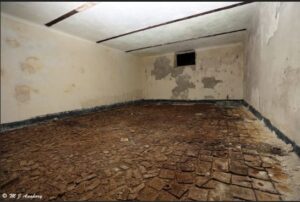 needed in a future war, but persistent rumors floated around about a secret chamber, and people continued to search for it. To me it is encouraging to know that it took people until December 26, 1996, to locate what they thought might be the chamber. That tells me that had the men been required to live in the room, they would probably have done so in absolute secrecy and safety. The suspicion about the room would persist for another decade, until finally, one of the six men who was supposed to partake in Operation Tracer confirmed that the room the explorers found in 1996, was indeed the room that was built for their top-secret operation all those years ago. It may be one of the best-kept secrets of World War II.
needed in a future war, but persistent rumors floated around about a secret chamber, and people continued to search for it. To me it is encouraging to know that it took people until December 26, 1996, to locate what they thought might be the chamber. That tells me that had the men been required to live in the room, they would probably have done so in absolute secrecy and safety. The suspicion about the room would persist for another decade, until finally, one of the six men who was supposed to partake in Operation Tracer confirmed that the room the explorers found in 1996, was indeed the room that was built for their top-secret operation all those years ago. It may be one of the best-kept secrets of World War II.

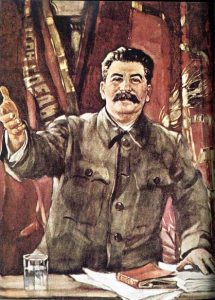 Generally speaking, a man’s word is his bond…as the saying goes, but when a man’s word can’t be trusted, well promises mean nothing, agreements mean nothing, partnership means nothing. The people who took Adolf Hitler at his word, found out the hard way, that Hitler was definitely not a man of his word. On June 22, 1941, after making an agreement, known as the Nazi-Soviet Pact of 1939, Nazi Germany at Hitler’s command, launched a massive invasion against the USSR. The agreement was basically that Germany and the USSR would not attack each other. Less than two years into the agreement, Hitler broke the agreement. He was most likely planning that invasion all along, but he needed to have the people of the USSR unaware of his plans. He needed to have them trust him, so his invasion would be a complete surprise attack.
Generally speaking, a man’s word is his bond…as the saying goes, but when a man’s word can’t be trusted, well promises mean nothing, agreements mean nothing, partnership means nothing. The people who took Adolf Hitler at his word, found out the hard way, that Hitler was definitely not a man of his word. On June 22, 1941, after making an agreement, known as the Nazi-Soviet Pact of 1939, Nazi Germany at Hitler’s command, launched a massive invasion against the USSR. The agreement was basically that Germany and the USSR would not attack each other. Less than two years into the agreement, Hitler broke the agreement. He was most likely planning that invasion all along, but he needed to have the people of the USSR unaware of his plans. He needed to have them trust him, so his invasion would be a complete surprise attack.
When he was ready, and aided by his far superior air force, Hitler sent his German army racing across the Russian plains. The German Army was given carte blanche in the invasion, and so they went about inflicting terrible casualties on the Red Army and the Soviet civilians. Of course, the German Army wasn’t alone in their attack. Their first targets of attack were Leningrad and Moscow. With the assistance of troops from their Axis allies, the Germans conquered the vast territory, and by mid-October the great Russian cities of Leningrad and Moscow were under siege. The Soviets held on, and the coming winter forced the German offensive to pause.
Hitler set his sights on the summer of 1942, and ordered the Sixth Army, under General Friedrich Paulus, to take Stalingrad in the south. Stalingrad was an industrial center and therefore, an obstacle to Nazi control of the precious Caucasus oil wells. The oil wells were a crucial part of the control process. The Army made advances across the Volga River in August, while the German Fourth Air Fleet reduced Stalingrad to burning rubble, killing more than 40,000 civilians. With the first attack behind them, Paulus ordered the first offensives into Stalingrad in September, estimating that it would take his army about 10 days to capture the city.
The ensuing battle was one of the most horrific battles of World War II. It was also quite likely the most important because it was the turning point in the war between Germany and the USSR. The USSR’s Red Army was furious and had an ax to grind over the ruined city and their lost loved ones and friends. Now, the German Sixth Army faced General Vasily Chuikov leading a bitter Red Army seeking revenge. They quickly transformed destroyed buildings and rubble into natural counter offensive fortifications. Then, using a method of fighting known as the Rattenkrieg or “Rat’s War,” the opposing forces broke into squads eight or 10 strong and fought each other for every house and yard of territory. The battle saw rapid advances in street-fighting technology. Things like a German machine gun that shot around corners and a light Russian plane that glided silently over German positions at night, dropping bombs without warning were birthed during this battle. The biggest problem the armies faced, however, was a lack of necessary food, water, or medical supplies, causing tens of thousands of soldiers to die every week.
The biggest miscalculation Hitler made was the resolve of Soviet leader Joseph Stalin, who was determined to liberate the city named after him. In November he ordered massive reinforcements to the area. On November 19, General Zhukov launched a great Soviet counteroffensive. German command underestimated the scale of the counterattack, and the Sixth Army was quickly overwhelmed by the offensive, which involved 500,000 Soviet troops, 900 tanks, and 1,400 aircraft. Within three days, the entire German force of more than 200,000 men was encircled. Before long, the Italian and Romanian troops at Stalingrad surrendered. That didn’t follow for the Germans, who hung on. Of course, Hitler would not let them surrender, so they waited…receiving limited supplies by air and waiting for reinforcements. Hitler ordered Paulus to remain in place and promoted him to field marshal, because no Nazi field marshal had ever surrendered.
The Germans lost as many lives to starvation and the bitter Russian winter, as they did to the merciless Soviet troops. Their supply line was completely cut off on January 21, 1943, when the last of the airports held by the Germans fell to the Soviets…completely cutting off their supplies. Despite Hitler’s threats, Paulus surrendered German forces in the southern sector on January 31, and on February 2 the remaining German troops surrendered. By the time Paulus surrendered, there were only 90,000 German soldiers still alive. They may 
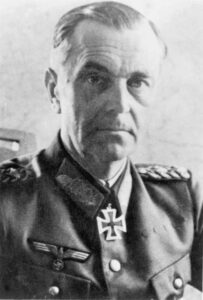 have thought they were among the lucky ones, but of the 90,000, only 5,000 survived the Soviet prisoner-of-war camps and make it back to Germany.
have thought they were among the lucky ones, but of the 90,000, only 5,000 survived the Soviet prisoner-of-war camps and make it back to Germany.
The Battle of Stalingrad was the turning point in the war between Germany and the Soviet Union. Chuikov had played such an important role in the victory. Later, it was he who led the Soviet drive on Berlin. As a reward, on May 1, 1945, he was given the right to personally accept the German surrender of Berlin. Paulus, who felt betrayed by Hitler, was among the German prisoners of war in the Soviet Union. He provided testimony at the International Military Tribunal at Nuremberg in 1946. After his release by the Soviets in 1953, he settled in East Germany.

 When the Nazis were trying to take over the world, one tool they felt was vital to their effort was the radio, or rather the control over the radio. If the Nazis could control the news people heard, they believed they could stop any resistance from the people, especially good people who didn’t want to be involved in the evil that Hitler was trying to carry out. The only way to control the situation was with the Nazi propaganda over controlled airwaves. The propaganda effort was a relatively new technology that the Nazis very likely pioneered.
When the Nazis were trying to take over the world, one tool they felt was vital to their effort was the radio, or rather the control over the radio. If the Nazis could control the news people heard, they believed they could stop any resistance from the people, especially good people who didn’t want to be involved in the evil that Hitler was trying to carry out. The only way to control the situation was with the Nazi propaganda over controlled airwaves. The propaganda effort was a relatively new technology that the Nazis very likely pioneered.
When the Germans first started their propaganda broadcasts, they were in both German and English. It was thought, by German propaganda minister, Joseph Goebbels, that since the United States had not entered the war, maybe they were still able to be turned toward German thinking. Within a few months of the breakout of World War II, German propagandists were transmitting no less than eleven hours of programming a day. In the first year of Nazi propaganda programming, broadcasters attempted to destroy pro-British feeling rather than arouse pro-German sentiment. I would assume that they were attempting to look like the innocent victim, and not the evil aggressor. These propagandists targeted certain groups, including capitalists, Jews, and selected newspapers/politicians. Doesn’t this sound like the media of today? By the summer of 1940, the Nazis, realizing that the United States would never be on their side, had abandoned all attempts to win American sympathy. The tone of German radio broadcasts quickly became critical towards the United States.
Goebbels, claimed the radio was the “eighth great power” and he, along with the Nazi party, recognized the power of the radio in the propaganda machine of Nazi Germany. Goebbels, recognizing the importance of radio in disseminating the Nazi message, quickly approved a mandate whereby millions of cheap radio sets were subsidized by the government and distributed to the German citizens. It reminds me of the “free cellphone” 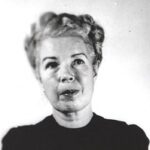
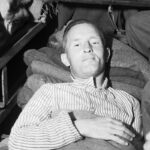 program of Barack Obama. It was Goebbels’ job to propagate the anti-Bolshevik statements of Hitler and aim them directly at neighboring countries with German-speaking minorities. In Goebbels’ “Radio as the Eighth Great Power” speech, he proclaimed, “It would not have been possible for us to take power or to use it in the ways we have without the radio…It is no exaggeration to say that the German revolution, at least in the form it took, would have been impossible without the airplane and the radio…[Radio] reached the entire nation, regardless of class, standing, or religion. That was primarily the result of the tight centralization, the strong reporting, and the up-to-date nature of the German radio.”
program of Barack Obama. It was Goebbels’ job to propagate the anti-Bolshevik statements of Hitler and aim them directly at neighboring countries with German-speaking minorities. In Goebbels’ “Radio as the Eighth Great Power” speech, he proclaimed, “It would not have been possible for us to take power or to use it in the ways we have without the radio…It is no exaggeration to say that the German revolution, at least in the form it took, would have been impossible without the airplane and the radio…[Radio] reached the entire nation, regardless of class, standing, or religion. That was primarily the result of the tight centralization, the strong reporting, and the up-to-date nature of the German radio.”
The Nazi regime began to use the radio to deliver its message to both occupied territories and enemy states, as well as domestic broadcasts. One of the main targets was the United Kingdom to which William Joyce broadcast regularly, gaining him the nickname “Lord Haw-Haw” in the process. Broadcasts were also made to the United States, notably through Robert Henry Best and Mildred ‘Axis Sally’ Gillars. As a normal practice of the Propaganda Minister’s office, the radio, just like the newspapers fell under strict German supervision during the occupation. In January 1941, Dutch stations were replaced by a single state-run broadcaster overseen by the NSB (Dutch Nazi Party). This station primarily transmitted pro-German programs.
The Dutch were not easily fooled, however. So, for news from the Allied camp the Dutch secretly listened to the BBC and Radio Oranje, the Dutch government’s radio station in exile, transmitting from London. One might wonder how that was possible, given the controls in place at the time, but people hardly paid attention to the 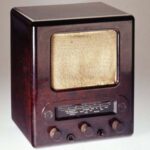
 listening ban imposed by the Germans. The occupying German forces tried to jam the reception of Radio Free Orange and the BBC, but with a handy device, easily made at home, the Dutch people were able to listen to broadcasts from London very little interference. It was therefore referred to as a moffenzeef (‘Kraut filter’) or ‘German filter’ because it sifted out jamming signals. The device was of monumental significance, because it kept the people from being effectively brainwashed by rogue media forms that were controlled by an evil government. The Kraut Filter might just have been the single greatest “non-weapon” of the war.
listening ban imposed by the Germans. The occupying German forces tried to jam the reception of Radio Free Orange and the BBC, but with a handy device, easily made at home, the Dutch people were able to listen to broadcasts from London very little interference. It was therefore referred to as a moffenzeef (‘Kraut filter’) or ‘German filter’ because it sifted out jamming signals. The device was of monumental significance, because it kept the people from being effectively brainwashed by rogue media forms that were controlled by an evil government. The Kraut Filter might just have been the single greatest “non-weapon” of the war.

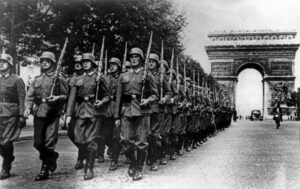 During World War II and even earlier really, Adolf Hitler was in the middle of his plan to take over the world. He was ruthless, and when he invaded a country, he didn’t care how many people died, as long as he got his way. The Battle of France took place between May 10, 1940 and June 25, 1940. The surrender of France to the Nazis in 1940 was a complex situation. The German invasion left metropolitan France at the mercy of Nazi armies. Really, once Paris fell on June 14, 1940, the German conquest of France was complete. Part of the problem was that Marshal Henri Petain replaced Paul Reynaud as prime minister and proved to be a weak leader who announced his intention to sign an armistice with the Nazis.
During World War II and even earlier really, Adolf Hitler was in the middle of his plan to take over the world. He was ruthless, and when he invaded a country, he didn’t care how many people died, as long as he got his way. The Battle of France took place between May 10, 1940 and June 25, 1940. The surrender of France to the Nazis in 1940 was a complex situation. The German invasion left metropolitan France at the mercy of Nazi armies. Really, once Paris fell on June 14, 1940, the German conquest of France was complete. Part of the problem was that Marshal Henri Petain replaced Paul Reynaud as prime minister and proved to be a weak leader who announced his intention to sign an armistice with the Nazis.
While not very well known at the time, French General Charles de Gaulle, made a broadcast on June 18, 1940, to France from England, where he would help with the resistance. The Appeal of June 18 was the first speech made by Charles de Gaulle after his arrival in London in 1940 following the Battle of France. The speech was broadcast to Vichy France by the radio services of the British Broadcasting Corporation (BBC). This speech is considered to have marked the beginning of the French Resistance in World War II. It is regarded as one of the most important speeches in French history. General de Gaulle said in his speech, “The leaders who, for many years, were at the head of French armies, have formed a government. This government, alleging our armies to be undone, agreed with the enemy to stop fighting. Of course, we were subdued by the mechanical, ground and air forces of the enemy. Infinitely more than their number, it was the tanks, the airplanes, the tactics of the Germans which made us retreat. It was the tanks, the airplanes, the tactics of the Germans that surprised our leaders to the point to bring them there where they are today.
But has the last word been said? Must hope disappear? Is defeat final? No!
Believe me, I speak to you with full knowledge of the facts and tell you that nothing is lost for France. The same means that overcame us can bring us to a day of victory. For France is not alone! She is not alone! She is not alone! She has a vast Empire behind her. She can align with the British Empire that holds the sea and continues the fight. She can, like England, use without limit the immense industry of United States.
This war is not limited to the unfortunate territory of our country. This war is not finished by the battle of France. This war is a world wide war. All the faults, all the delays, all the suffering, do not prevent there to be, in the world, all the necessary means to one day crush our enemies. Vanquished today by mechanical force, we will be able to overcome in the future by a superior mechanical force.
The destiny of the world is here. I, General de Gaulle, currently in London, invite the officers and the French soldiers who are located in British territory or who would come there, with their weapons or without their weapons, I invite the engineers and the special workers of armament industries who are located in British territory or who would come there, to put themselves in contact with me.
Whatever happens, the flame of the French resistance must not be extinguished and will not be extinguished.”
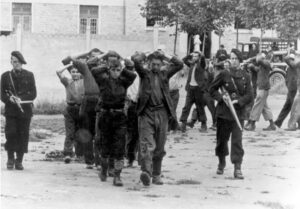
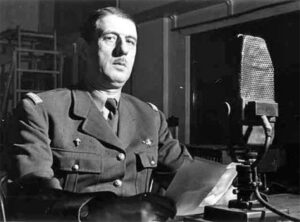 His work with the French Resistance made Charles de Gaulle almost a household word in France. It gave the people hope for freedom. The French Resistance fought to the death to beat the Nazis. This makes me think of current times, and all the freedoms that we have lost. These lessons from the French Resistance are valuable to this day. Never give up. You only lose a battle when you quit fighting. We must never quit fighting.
His work with the French Resistance made Charles de Gaulle almost a household word in France. It gave the people hope for freedom. The French Resistance fought to the death to beat the Nazis. This makes me think of current times, and all the freedoms that we have lost. These lessons from the French Resistance are valuable to this day. Never give up. You only lose a battle when you quit fighting. We must never quit fighting.
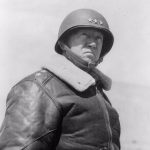 In the final years of World War II, both the Allied and Axis Powers knew that there was no chance of defeating Hitler without cracking his grasp on Western Europe, and both sides knew that Northern France was the obvious target for an amphibious assault. Hitler’s army seemed to be everywhere. That said, the Allied forces knew they had to come up with a way to “fool” the leader of the Third Reich. Hitler arrogantly thought that he knew what the Allied forces were planning, and that was the best way to create his downfall. The German high command assumed the Allies would cross from England to France at the narrowest part of the channel and land at Pas-de-Calais. The Allies used that to their advantage and decided on the beaches of Normandy…some 200 miles to the west. The beaches of Normandy could be taken as they were, but if the Germans added to their defense by moving their reserve infantry and panzers to Normandy from their garrison in the Pas-de-Calais region, the invasion would be a disaster.
In the final years of World War II, both the Allied and Axis Powers knew that there was no chance of defeating Hitler without cracking his grasp on Western Europe, and both sides knew that Northern France was the obvious target for an amphibious assault. Hitler’s army seemed to be everywhere. That said, the Allied forces knew they had to come up with a way to “fool” the leader of the Third Reich. Hitler arrogantly thought that he knew what the Allied forces were planning, and that was the best way to create his downfall. The German high command assumed the Allies would cross from England to France at the narrowest part of the channel and land at Pas-de-Calais. The Allies used that to their advantage and decided on the beaches of Normandy…some 200 miles to the west. The beaches of Normandy could be taken as they were, but if the Germans added to their defense by moving their reserve infantry and panzers to Normandy from their garrison in the Pas-de-Calais region, the invasion would be a disaster.
In what would become an ingenious plan, the Allied intelligence services created two fake armies to keep the Germans on their toes. One would wonder how they proposed to pull that off. The Allies created two “Ghost Armies.” One would be based in Scotland to create a supposed invasion of Norway and the other headquartered 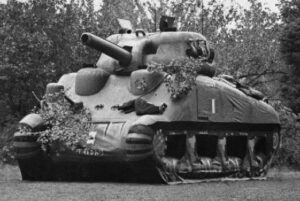 in southeast England to threaten the Pas-de-Calais. While the operation in Scotland relied mainly on fake radio traffic and the feeding of false information to double agents to create the impression of a substantial army, the southern “Ghost Army” had to seem much more real. The fortitude South was well within the range of prying German ears and eyes, so fake chatter alone would be uncovered too quickly. It had to look and sound like a substantial army was building up in southeast England. They needed boots on the ground there, without actually using too much of their precious manpower. That seems like a monumental task.
in southeast England to threaten the Pas-de-Calais. While the operation in Scotland relied mainly on fake radio traffic and the feeding of false information to double agents to create the impression of a substantial army, the southern “Ghost Army” had to seem much more real. The fortitude South was well within the range of prying German ears and eyes, so fake chatter alone would be uncovered too quickly. It had to look and sound like a substantial army was building up in southeast England. They needed boots on the ground there, without actually using too much of their precious manpower. That seems like a monumental task.
Enter George and his imaginary men. Patton was put in charge of leading a fake army, commonly known as the “Ghost Army” as part of a massive counterintelligence operation preceding D-Day. The “Ghost Army” was an army of inflatable tanks, rubber airplanes, and fake radio signals designed to trick the German army. The mission was insanely successful. The “Ghost Army” was a United States Army tactical deception unit used during World War II officially known as the 23rd Headquarters Special Troops. The 1100-man unit was given a  unique mission within the Allied Army. Their orders…impersonate other Allied Army units to deceive the enemy. It was simple, but it wouldn’t be easy.
unique mission within the Allied Army. Their orders…impersonate other Allied Army units to deceive the enemy. It was simple, but it wouldn’t be easy.
By the evening of June 6, 1944, in what would become known as D-Day, the First Army landed at Normandy. The battle was on, and without the extra troops Hitler might have sent if he wasn’t misled so completely. By June 23, 1945, the 23rd Headquarters Special Troops was on its way home after having served with four US armies through England, France, Luxembourg, Belgium, Holland, and Germany. During their tenure, they put on what many would call a “traveling road show” utilizing inflatable tanks, sound trucks, fake radio transmissions, scripts, and pretense. They staged more than 20 battlefield deceptions, often operating very close to the front lines. While their missions and their work were amazing, their story was kept secret for more than 40 years after the war, until it was declassified in 1996.
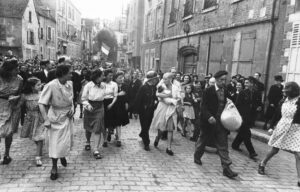 Having a baby is normally a blessed event, but it is also important to be having the baby with the right person. I know that sound like something that is between the man and the woman, and it’s nobody’s business but their own, and I would agree with you on that. However, during World War II, the Nazi regime was so hated that the nations they terrorized didn’t want anything to do with them…so much so that French women having babies with German soldiers were punished by shaving their heads bald and parading them through town. This was done so that everyone would know they betrayed their country, and so they had.
Having a baby is normally a blessed event, but it is also important to be having the baby with the right person. I know that sound like something that is between the man and the woman, and it’s nobody’s business but their own, and I would agree with you on that. However, during World War II, the Nazi regime was so hated that the nations they terrorized didn’t want anything to do with them…so much so that French women having babies with German soldiers were punished by shaving their heads bald and parading them through town. This was done so that everyone would know they betrayed their country, and so they had.
The Nazi regime was set on creating “the perfect race,” in their opinion anyway. They wanted everyone to be light skinned, blond haired, and blue eyed, and those who weren’t had to prove their genetic lines. The Nazis even went so far as to set up places that women (of the right bloodlines) were sent to have their children, conceived with German soldiers. Then, the plan was that they would give their children up for adoption by a Nazi couple who was having trouble conceiving. It was Hitler’s way of preserving the “right” bloodline. Many times, if the woman changed her mind, and wanted to keep the baby, but refused to marry the soldier, their babies were taken from the by force, even if it meant taking their lives. Some of these 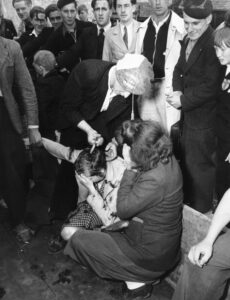 women were in it for the money and had no intention of keeping their babies. They were a simply a “Nazi Baby Machine.”
women were in it for the money and had no intention of keeping their babies. They were a simply a “Nazi Baby Machine.”
Once it was discovered that these women were doing this, they were marked as traitors. Often their own families disowned them. These women might not even be having babies with the Nazi soldiers, just having relations with them. The soldiers saw nothing wrong with hooking up with these women to ply them for information. It was an act of treason on the part of the women. They shouldn’t have allowed themselves to become involved with the Nazi soldiers, because they just had to know that was wrong. Treason is such a dark side of war. Still, there are many dark sides to war, and in most cases, it is the innocent and oppressed that suffer.
The French resistance brought out another dark side to the war, and it was rather brutal, but they felt like it was justified. Looking at it now, I think the beating part was the probably brutal, but maybe still have been justified. Basically, the French Resistance, when women were caught in a physical relationship with a Nazi, shaved their heads, beat the women who had been charged with collaborating with the enemy, and then paraded them around town as a form of punishment. The punishment was followed by harassing the women, with no repercussion for the beatings, head shavings, or the harassing. In France, a woman’s long hair is supposed to be seductive, so shaving their heads, was a way to make them look undesirable. The practice dates back to Biblical times. It was a common punishment for adultery. During the 20th century, it was reintroduced as a means to ridicule women who had physical relationships with the enemy or were prostitutes.  The French Resistance took a page from Bible times, and so it came to pass that during World War II, this act of humiliation was repeated on French women accused of collaborating with the German soldiers. Apart from shaving their heads, they were paraded in the streets, marked with black ink, and even stripped half-naked. At least 20,000 women have been documented to have had their heads shaved. I’m not a proponent of violence, but traitors need to be punished, and after something like that, I would think these women would think twice before getting involved with the Nazi soldiers. and any woman who hadn’t done so, would think twice before even considering such a heinous act.
The French Resistance took a page from Bible times, and so it came to pass that during World War II, this act of humiliation was repeated on French women accused of collaborating with the German soldiers. Apart from shaving their heads, they were paraded in the streets, marked with black ink, and even stripped half-naked. At least 20,000 women have been documented to have had their heads shaved. I’m not a proponent of violence, but traitors need to be punished, and after something like that, I would think these women would think twice before getting involved with the Nazi soldiers. and any woman who hadn’t done so, would think twice before even considering such a heinous act.
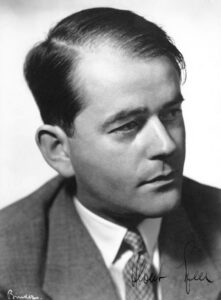 As Hitler continued his reign of terror over the people of Germany, in his quest to rule the world, he decided that he needed to destroy much of the German infrastructure so that the Allied forces couldn’t use it as they penetrated deep withing the borders of Germany. Hitler must have known by now that he was losing this war, even in his crazed state, so he was trying to find a way to turn the tide.
As Hitler continued his reign of terror over the people of Germany, in his quest to rule the world, he decided that he needed to destroy much of the German infrastructure so that the Allied forces couldn’t use it as they penetrated deep withing the borders of Germany. Hitler must have known by now that he was losing this war, even in his crazed state, so he was trying to find a way to turn the tide.
The Nero Decree (German: Nerobefehl) was the order issued by Hitler on March 19, 1945, right after the Allies captured the final bridge on the Rhine River that allowed access into Germany. The Nero Decree ordered the destruction of large numbers of bridges in Germany. The official name was Decree Concerning Demolitions in the Reich Territory (Befehl betreffend Zerstörungsmaßnahmen im Reichsgebiet), but that is rather a long name, so it became known as the Nero Decree, after the Roman Emperor Nero, who, according to an apocryphal story, “engineered the Great Fire of Rome in 64 AD.”

This act would have wiped out all of Germany’s industry and infrastructure just to keep it from falling under Allied control. Hitler didn’t care about that or about the people who would be affected. The actual task of carrying out such destruction fell to Germany’s armaments minister…and Hitler’s friend, Albert Speer. Speer knew that to follow the order would have a ruinous effect on the German people, so like Von Choltitz, who had disobeyed the order to burn Paris, Speer deliberately disobeyed the order of his friend, who he suspected was mentally unstable. In addition, Speer also issued encrypted alternate orders to delay the destruction. In the end, the Nero Decree wasn’t carried out at all, something which I’m quite certain drove Hitler totally insane.
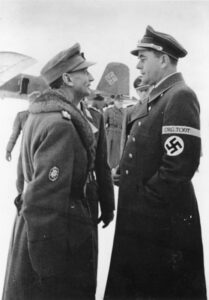
Speer was one of the highest-ranking members of German leadership to survive the war. He attempted to promote himself as someone who stood up to Hitler. While history does credit him with refusing to follow the Nero Decree, it did not completely exonerate him. Speer was an architect, and he wanted to preserve many buildings he had designed. Berthold Konrad Hermann Albert Speer, born March 19, 1905, in Mannheim, into an upper-middle-class family. He was the second of three sons of Luise Máthilde Wilhelmine (Hommel) and Albert Friedrich Speer. He was a German architect who served as the Minister of Armaments and War Production in Nazi Germany during most of World War II. He was also a close ally of Adolf Hitler, a relationship which would cause him to be convicted at the Nuremberg trials and sentenced to 20 years in prison. Speer returned to London in 1981 to participate in the BBC Newsnight program. He suffered a stroke and died in London on September 1, 1981.
 When Hitler began his reign of terror, he fully expected that he would meet with little resistance from the people he was attempting to control, but that really never turned out to be the case. Even some of those who aligned themselves with him at first, rebelled later. Hitler found that out when, on November 18, 1940, he met with Italian Foreign Minister Galeazzo Ciano over Mussolini’s disastrous invasion of Greece.
When Hitler began his reign of terror, he fully expected that he would meet with little resistance from the people he was attempting to control, but that really never turned out to be the case. Even some of those who aligned themselves with him at first, rebelled later. Hitler found that out when, on November 18, 1940, he met with Italian Foreign Minister Galeazzo Ciano over Mussolini’s disastrous invasion of Greece.
Mussolini had led Hitler to believe that he had no intention of attempting to invade Greece. Then, he surprised everyone with a attempted invasion of Greece. Even his ally…Hitler, was caught off guard, since Mussolini had led Hitler to believe he had no such intention. Even Mussolini’s own chief of army staff only found out about the invasion after the fact!!
Mussolini was warned against trying to invade Greece. Everyone around him knew that the Greek people were determined to hold onto their freedom, and that the Italian Army was woefully unprepared for such an attack. Even his own generals warned of a lack of preparedness on the part of his military. Nevertheless, and despite the fact that it would mean getting bogged down in a mountainous country during the rainy season against an army willing to fight tooth and nail to defend its autonomy, Mussolini moved ahead mostly out of sheer arrogance, convinced he could defeat the “inferior Greeks” in a matter of days. He also knew a secret, that millions of Lire (The primary unit of currency in Italy, Malta, San Marino, and the Vatican City before the adoption of the Euro) had been put aside to bribe Greek politicians and generals not to resist the Italian invasion. The whole bribe idea didn’t work out too well, however. Whether the money ever made it past the Italian fascist agents delegated with the responsibility is unclear, but if it did, it clearly made no difference. The Greeks pushed the Italian invaders back into Albania after just one week. The whole operation was a miserable failure, and the Italians spent the next three months fighting for life in a fierce, defensive battle. To make matters worse, about half the Italian fleet had been crippled by a British carrier-based attack at Taranto.
A furious Hitler severely criticized Ciano at their meeting in Obersalzberg, for opening an opportunity for the British to enter Greece and establish an airbase in Athens. That put the Brits within striking distance of valuable 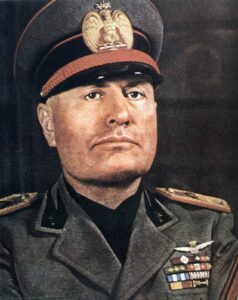 oil reserves in Romania that Hitler needed for his war machine. Hitler now had to divert forces from North Africa, a high strategic priority, to Greece in order to bail Mussolini out. He actually considered leaving the Italians to fight their own way out of the mess, and considered making peace with the Greeks as a way of forestalling an Allied intervention. Nevertheless, Germany would have to invade, in April 1941, thereby adding Greece to its list of conquests…whether Hitler wanted to or not. That put the Brits within striking distance of valuable oil reserves in Romania that Hitler needed for his war machine. Hitler now had to divert forces from North Africa, a high strategic priority, to Greece in order to bail Mussolini out. He actually considered leaving the Italians to fight their own way out of the mess, and considered making peace with the Greeks as a way of forestalling an Allied intervention. Nevertheless, Germany would have to invade, in April 1941, thereby adding Greece to its list of conquests…whether Hitler wanted to or not.
oil reserves in Romania that Hitler needed for his war machine. Hitler now had to divert forces from North Africa, a high strategic priority, to Greece in order to bail Mussolini out. He actually considered leaving the Italians to fight their own way out of the mess, and considered making peace with the Greeks as a way of forestalling an Allied intervention. Nevertheless, Germany would have to invade, in April 1941, thereby adding Greece to its list of conquests…whether Hitler wanted to or not. That put the Brits within striking distance of valuable oil reserves in Romania that Hitler needed for his war machine. Hitler now had to divert forces from North Africa, a high strategic priority, to Greece in order to bail Mussolini out. He actually considered leaving the Italians to fight their own way out of the mess, and considered making peace with the Greeks as a way of forestalling an Allied intervention. Nevertheless, Germany would have to invade, in April 1941, thereby adding Greece to its list of conquests…whether Hitler wanted to or not.

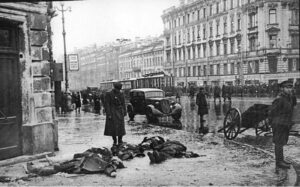 In reality, they gave science a bad name. The calculations made by German scientists before the invasion of Leningrad was launched in September of 1941, estimated that as many as 30 million Russian civilians would succumb to starvation. Hitler’s plan was to annihilate the Russian population and establish new German colonies in Eastern Europe. Hitler had a very specific idea of “the perfect race” and he would stop at nothing to achieve his goal.
In reality, they gave science a bad name. The calculations made by German scientists before the invasion of Leningrad was launched in September of 1941, estimated that as many as 30 million Russian civilians would succumb to starvation. Hitler’s plan was to annihilate the Russian population and establish new German colonies in Eastern Europe. Hitler had a very specific idea of “the perfect race” and he would stop at nothing to achieve his goal.
The people of Leningrad would experience Hitler’s cold German indifference to suffering firsthand. I suppose “German indifference” isn’t totally fair, because many of the German people were against the cruelty Hitler was so comfortable with. When the city was surrounded by September 1941, the Axis forces chose not to close in and engage in costly urban fighting, but to pound Leningrad from a safe distance and let hunger do the rest. They planned to block all transportation of vehicles in and out of the city, until all food ran out, and the people died from starvation.
Hitler’s plan left out one thing…a Surrender Option. The people could not surrender and live. They wanted then to die, and that was going to be their only option. Hitler’s direct order was to ignore the offer to surrender, saying “Requests for surrender resulting from the city’s encirclement will be denied, since the problem of relocating and feeding the population cannot and should not be solved by us.”
Hitler was ruthless. The city’s water and food supplies were cut off, and extreme famine soon set in. The siege of Leningrad began on September 8, 1941, and ended after a grueling two-year period on January 27, 1944. Yes, the siege produced starvation and disease, but Hitler took it a step further…to psychological torment. On Hitler’s orders, Leningrad suffered a daily barrage of artillery attacks from the German and Finnish forces that encircled it. The people were already starving, and lack of food or drink for long periods of time, can make something like an artillery attack, be that much more unsettling…even to the point of more than terror. They are dealing with gnawing hunger, and the terror of wondering if the artillery will hit them, and they should be, because Hitler would not care if he hit a civilian, accidently or on purpose. The people had no recourse, and no way out. After 872 days of starvation, disease, and the artillery attacks, the citizens of Leningrad…the ones who 
 were left anyway, were freed, but to what. Their city had been overtaken, many had family members who had died, their businesses were gone, their homes were gone…they had lost it all. In total, roughly 1.5 million people were killed during the siege of Leningrad while some 1.4 million were evacuated. I’m sure Hitler was still disappointed with the outcome, because he wanted them all dead.
were left anyway, were freed, but to what. Their city had been overtaken, many had family members who had died, their businesses were gone, their homes were gone…they had lost it all. In total, roughly 1.5 million people were killed during the siege of Leningrad while some 1.4 million were evacuated. I’m sure Hitler was still disappointed with the outcome, because he wanted them all dead.

